The world runs on 3D
3D design. Somehow everyone seems to have an idea of what it is. But it’s like the offside rule in soccer – if someone asks you to explain it, things become tricky for the casual viewer.

As Investors, we have been excited about 3D for a while. It can be a humongous opportunity for founders. As evidenced by the team and the amazing community at Speckle, who today broke news about their $6.5M seed round co-led by Frontline and Matrix Partners, and a host of amazing angels such as the co-founders of Sentry, Plangrid, Built Technologies and many other friends. We had led Speckle’s pre-seed round in 2020 and are excited to finally lift the curtain on what we think is one of the hottest tech companies in 3D. So let’s talk 3D.
Up until a few months ago, not many people outside the experts cared much about it. And then something happened recently which made talking about 3D design a lot more relevant to a lot more people: the metaverse. Sounds like a curve ball, let me explain…
The media attention the metaverse has received shed light on the incredible technological development related to the 3D world such as, ever-improving graphics processing units (GPUs), photorealistic 3D engines, and faster content generation through volumetric video. In other words, it substantiated a claim we had been excited about, for some time:
That our world runs on 3D.
2D has been in the investment news for the past decade – with Figma, Canva, Miro, more recently Pitch and the likes, breaking funding headlines. So you could say – investors haven’t really appreciated the potential of 3D until recently.
Well: the importance of 3D is no news to the architecture, engineering and construction (AEC) industry, where the potential for 3D design has been supported by a community of architects and 3D designers over the last five decades.
And yes, every tool needs a craftsman. Architects are able to indulge in their design visions, while engineers are able to build more complex, geometrical structures than ever before. We believe creators can expand their relevance even further, as we rely on 3D design technologies to enable us to build with less **wasted materials and more creativity.
And yet, with all its massive potential, 3D design has been a crazy pain in the
for architects, gaming developers, media and movie designers, and everyone else who uses 3D software. Let’s call them 3D creators.
3D is shackled
The pain that 3D creators experience is diverse and comes in many forms. We’ve found that most of the root causes fall into one of the following five buckets:
1/ Vendor silos and lack of interoperability
3D software is a mishmash mix of authoring tools and specialty software. All of them need a full or partial 3D model to interact with. So you would think: hey, if they all use the same kind of model, it should be quite open? Well, let me tell you: it’s not. In fact, it’s the opposite. Tons of vendors are building 3D software. A few selected ones have done a bunch of acquisitions of smaller 3D point-solutions to integrate. What those silos do is create vendor lock-ins and disallow interoperability. Amongst other things, this results in unsynced data between software silos and a loss of meta information from one software to the other (eg. change logs, access rights, time stamps).
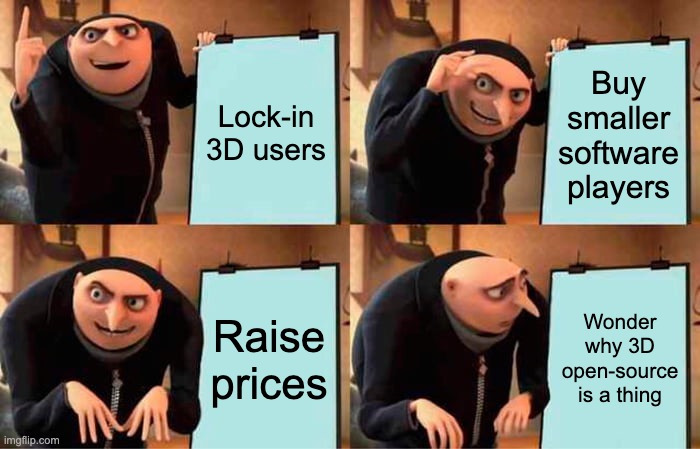
2/ File-bound
So when we say that all 3D software run on the same kind of model, you’d think those models are properly normed and standardized. Bad luck, they’re not. A bunch of file formats – some proprietary, some more generally adopted – are in use. But the worst part is: it’s FILES. It’s big, unstructured, opaque blobs of 300+ megabytes that 3D creators have to store, send around, upload in order to share and collaborate. Terrible idea to have 3D run on big blobs of files. The result? Long and manually tedious file sharing download and upload times, and you never find the one granular object you need to work on easily.
3/ No true multiplayer – 3D is play-by-email at factor 300x
Which leads me to the fact that 3D creators are essentially single-players playing a multi-player in the play-by-email (PBEM) format. Any readers here old enough to remember PBEM ? If yes it means you’ve been around in the 80s and 90s and sending saved-games to your buddies (like me) when you finished your turn, and then your buddy loads your saved-game to run their turn, and so on. PBEM is the amount of multiplayer we have today in 3D. It’s a crazy disaster, because we 3D creators PBEM with 300+ megabyte large blob-files – which are not just way too large, but they never contain exactly the information that my multiplayer buddy needs. Maybe my co-creator only needs certain objects (eg. columns, windows, pipes) to run their analysis on. But the reality is: I have to send them my entire big-blob model because the file does not allow me to properly structure and filter down to send them only the objects that they need. For instance, an architect makes a conceptual change that the engineer in another firm then has to translate into engineering. Every single change leads to multiple iterations, which makes the software silos even more unbearable. 3D today comes without multiplayer. It is PBEM.
4/ On-prem is still a thing
One of the most dazzling oxymorons of the 3D software space is that on one hand, the software are highly sophisticated pieces able to run complex operations, but on the other hand so backwards and unsophisticated that many of them still run on-premise. The move towards cloud and subscriptions – while underway for many years – is surprisingly slow and laggard here. While we don’t have an exact number, our anecdotal guesstimate is that 50%+ of software is still on-prem. Quite frankly, I wouldn’t be surprised if a fair share of vendors still distribute their 3D software on CD-ROMs, like this gem here.
5/ 3D is exponentially more complex
Finally, all of the root causes above are powered by one first principle: that 3D operations are exponentially more complex than 2D. It is more complex on the software engineering side – which means that 3D authoring tools have a crazy-high minimum feature set to actually add value for the creator. In Figma, you maybe need a dozen or so features. In a 3D authoring tool, you need hundreds to thousands of features to make sense for the creator. And that makes 3D also more complex on the user-side – in order to master authoring tools plus the hundreds of point-solutions and specialty software, a user has to have thousands of hours of training and experience operating the software. 3D is exponentially more complex than 2D.
3D without Speckle is like play-by-email at factor 300x
That’s the reality we live in today. Before we move forward in time and see how Speckle fixes all this – let’s do the scenic route and move back in time. What the f happened to get us into this 3D mess?
Darwinism at work: The humble beginnings of 3D
Ever heard of computer-aided design (CAD)?
Despite well-known inefficiencies, the AEC industry has not evolved without some technological wins. One particular and early-days technological breakthrough which had eradicated many design errors and drastically improved accuracy in the construction industry are CAD systems. CAD refers to the use of computer systems in assistance of the creation, modification, and analysis of a design.
In the past, calculations used to be performed by hand. CAD offered a truly revolutionary change by taking over that burden. The system did not eliminate any department of draftsmen, engineers and designers, rather, it empowered departments and merged them, ensuring a more efficient and streamlined engineering process.
CAD started 60 years ago (yep, you heard that right)
Let’s dig into a brief history of CAD:
The first-generation CAD software systems were expensive and specialized computers that only a select few could afford. They were mostly 2D drafting applications. These were developed by a company’s internal IT group and only intended to automate repetitive drafting chores.
The world’s first commercial CAD software was a numerical programming tool known as PRONTO. This tool was designed in 1957 by Dr Patrick J Hanratty, who has become known as the ‘Father of CAD CAM.’ Soon after, Ivan Sutherland in the early 1960’s, developed ‘sketchpad.’ What made Sketchpad so ground-breaking was the fact that it offered designers a way to graphically interact with the computer. This was done by drawing on the computers with what is known as a ‘light pen.’
It was during the mid-1970’s that CAD systems started to offer more services than simply the ability to reproduce manual drafting. Business owners began seeing the benefits of CAD systems over manual drafting tools, including the capability of automated generation – something we take for granted today.
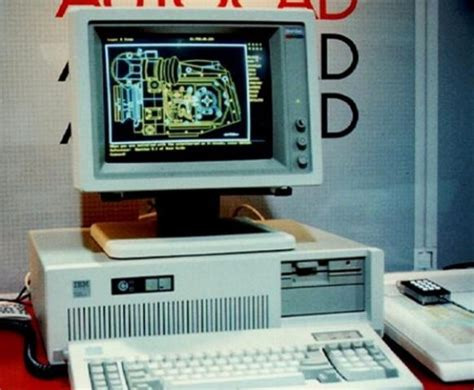
And developed over the past decades into a standard tool for creators
Since the early dawns of the digital age in the 80s and 90s, creators became able to purchase CAD software that runs on personal computers. In fact, there are now more than 6,000 design software just for the construction industry currently.
CAD has become part of any standard academic curriculum around the globe. No architect or engineer designing buildings or products would be crazy enough to live without CAD. That’s how ubiquitous it has become.
However, in spite of how long CAD has been around – and how ubiquitous it is among 3D creators – some community members have made the case that maybe vendors lack incentive to truly solve the root issues with their 3D software. Why would they? The way things are are very profitable for them, with one example making $3.5B in gross profit with a 90% gross profit margin last year.
The old way prints dollars for them. All while their 3D software remain shackled and fairly single-player. So it’s about time for a superior solution to evolve the way we do 3D.
Which leads us to why we think that Speckle is the first true game-changer in 3D design for the past 60 years…
Fast-forward to 2020: Dimitrie, Matteo and their army of creators begin to change 3D forever
For us, our Speckle-verse journey started with a typical Dimitrie-esque charming email:
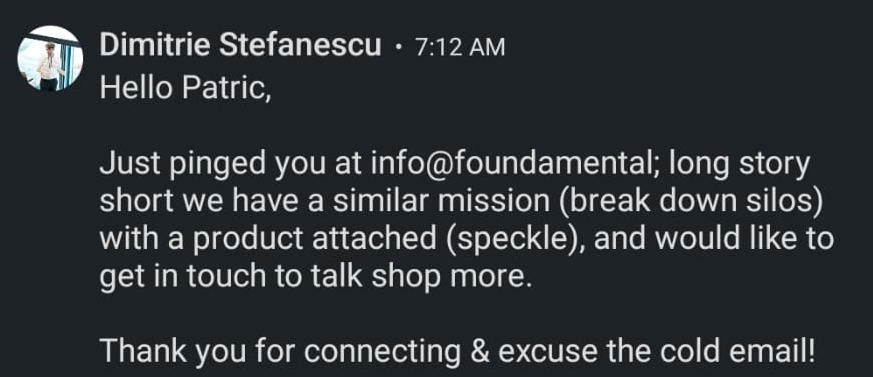
We read the deck, and got in front of Dimitrie and Matteo the same day. While the business was pre-seed and pre-revenue at the time – the product was in its infant stages – but the tech had tons of promise. What was visible in that first chat right away was the founders’ passion for 3D and their hate of the status quo. It became glaringly obvious that this was a case of two founders on a mission.

It took us about 30 minutes after the call to ring Dimitrie and Matteo back up, and ask them to come to our Europe-office in Berlin right away. Which, gladly for us, they accepted. We met a few days later and spent 6 hours workshopping around an open-source go-to market, product strategy, technology edge, hiring plans, and equity story for future raises. Boy, it was inspiring.
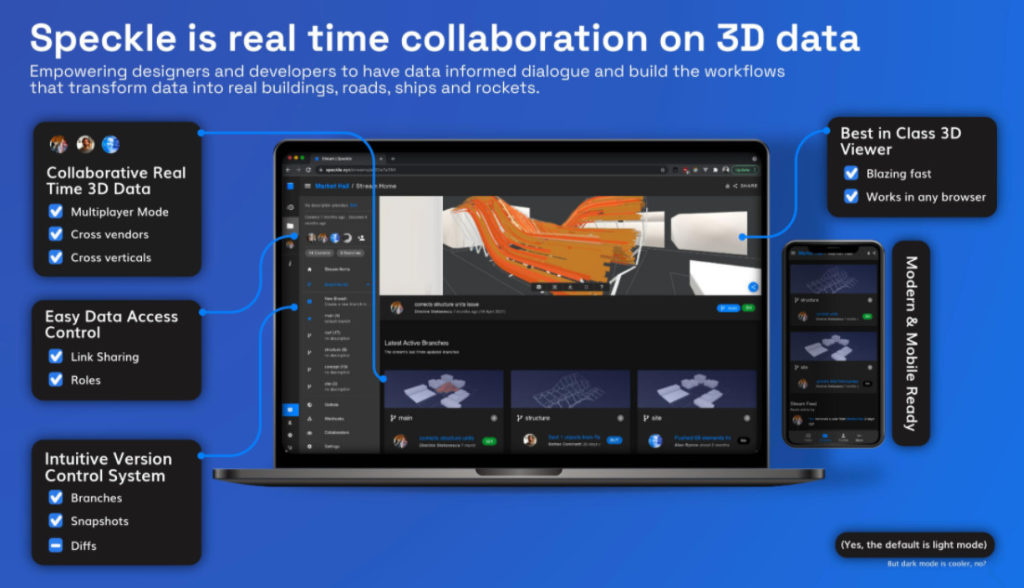
What we learnt from the time spent with Dimitrie and Matteo is that they can be incredibly fun to work with and are instant fan-favorites. While humble and confident enough to say out loud what they don’t know, they had strong and fact-based convictions about things they knew. It was a real fireworks of problem-solving, at the end of which, we already had the intuition that we wanted to do something here to partner with them.
We all shared the key values about Speckle – most importantly, the community-first and open-source approach.
While Dimitrie and Matteo agreed to do some more work – mostly around technical details such as refining their ops model and the hiring plan – we secretly were already in love. It was one of those times when you knew you want to eventually marry that other person after your second date, but you play it cool and distant enough to stay attractive and not scare them away with your “hey I’m easy to get” eagerness.
We had the feeling at this point that the key ingredients that would unlock Speckle to become a wild success seemed in place:
- Founders with great feeling for the product and tech magicians
- Unfair insight of having lived through pains of creating in 3D from their past experiences at Foster Partners, Arup, WeWork and Henn
- Great community DNA, with an army of thousands of users and creators on top of Speckle
- Fantastic recruitment story and access to talent via the community
- Awesome founder-to-founder dynamic; true brothers-of-another-mother
- On a mission, fueled by knowing a better way to do something of importance, and a little bit of hate of vendors who squeeze customers dry
- Insanely large market, with the built world running on 3D
Hindsight is always 20-20, but in this case, I am stupid enough to admit: it really was glaringly obvious that the ingredients are near-perfect.
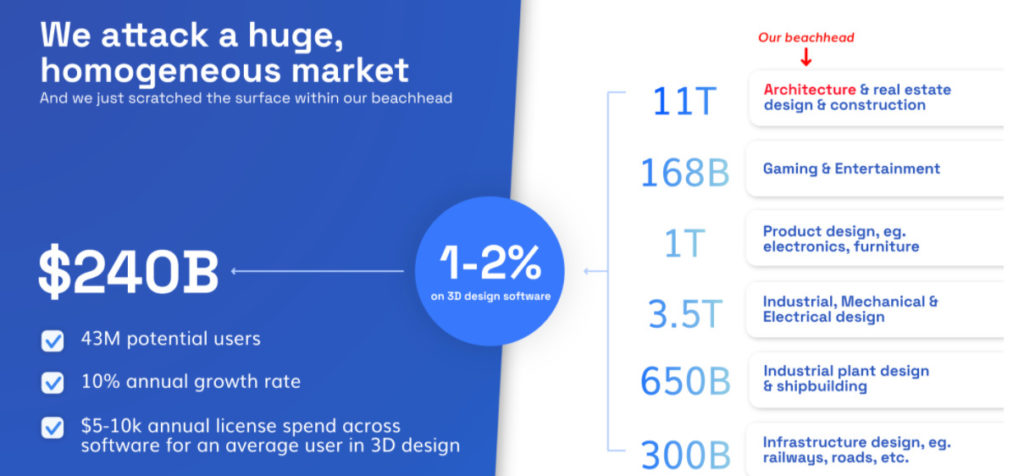
So all we had to agree on at that point was how to execute.
What makes the Speckle tech so special …
No need for us to come up with a good explanation. Take it straight from the data room from Speckle’s seed round:
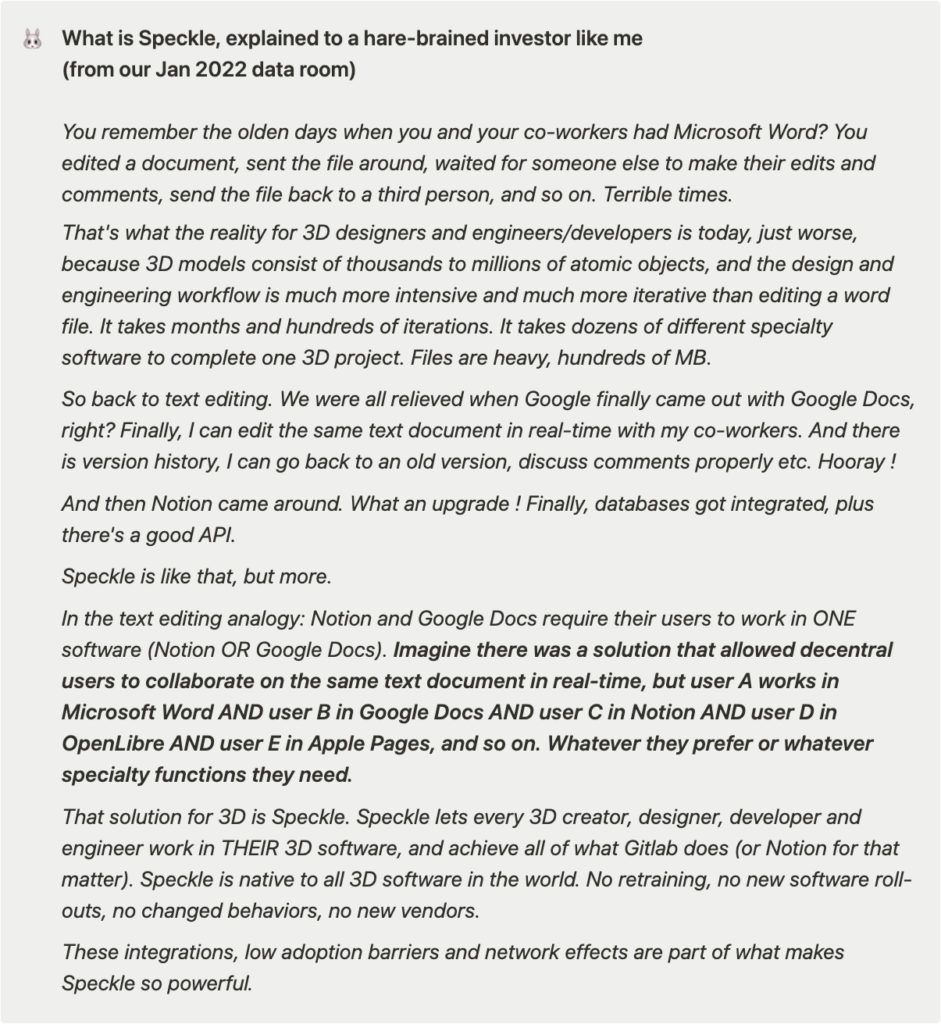
The analogy we used in the data room describes Speckle surprisingly well (though sells it waaaaaay short). The underlying tech is powered by a scalable multi-backend object graph persistence system. Think of it like git, but for in-memory objects. It maintains the structure and semantics of original objects, which is key for complex 3D models consisting of hundreds of thousands of objects.
Dimitrie’s original research found a scalable way to decompose objects in their atomic components, in the way that creators, developers or designers define them in their model, as they build.
Speckle then stores and normalizes the object data in a proprietary manner with some secret-sauce that allows to access and distribute the objects either structurally – eg. via GraphQL – or flat where required. But in any case: structured.
This secret sauce unlocks open inter-operability and true multi-player.
Here you are seeing two creators collaborating on the same model from two remote places in two different 3D software at the same time. One creator works on the model in Rhino, the other works in Revit. The left creator updates her 3D model, the right creator receives her updated 3D model in real-time. Speckle stores the version history, the commits, allows comments, and everything else as a full-blown Git for 3D.
While the tech is amazing and highly differentiated, what makes Speckle so powerful goes beyond the tech. Speckle is a streamlined workflow tool with which creators + non-technical users (eg. their clients, their department heads) collaborate, curate and decide on 3D data in real-time.
Open-source shifts 3D to FreeD
We learnt from working with Dimitrie and Matteo that 3D creators, engineers, developers, architects, designers are a vast technical community around the globe, with tens of millions of creators. We estimate anecdotally that around 15% of 3D creators are technical – i.e. they can write sophisticated code. And that number is only increasing from here.
More importantly, the community-dynamics are such that creators tend to hate the old ways. Remember above how we spoke about legacy 3D vendors creating lock-ins and squeezing users? Well, turns out creators don’t find that very funny, and they are united as a community against it. Take this small example.
The disconnect and non-interoperability that some legacy vendors actively drive is only solvable via a true open-source project. That’s what we believe.
We also believe that grassroots-up is a highly efficient form of distribution for 3D creators – who spend days in front of their screen, who exchange best practices in discords, forums on twitter and in slack channels very, very frequently and across the global borders.
So when Dimitrie and Matteo pitched us that Speckle MUST be open-source – we fully bought-in within minutes (true story). And all creators backing the Speckle community, all partners such as us alike, believe the same thing – that Speckle will drive 3D multi-player and breaking the 3D shackles BECAUSE Speckle is open-sourced and backed by an amazing technical community spanning the globe and huge in size.
3D becomes FreeD because Speckle is built open-source.
What’s next in FreeD?
Speckle has made unbelievable progress since mid-2020:
Dozens of software integrated;
Thousands of recurring users, growing at 20%+ MoM organically and without any marketing (in fact, Speckle famously spent $16 on marketing in the past 2 years);
40 Million objects pushed through Speckle’s pipes;
Backed by an amazing and fast-growing 3D creator community.
That said, we can’t be satisfied. While the tech that Dimitrie and Matteo invented is incredible, the mission is to move 3D to become FreeD. Ultimately, we partnered with Speckle to support them to break the shackles of 3D vendor lock-ins.
3D will only grow from here, and our entire world will ultimately run on 3D. To be fair, when we first met Dim and Matteo, we did not use the term Metaverse (and I hate it to this day), but it was already clear in the built-world, industrial-world and gaming realms back then, and has only grown stronger.
We believe that 3D is quickly becoming the next design frontier (much bigger than just the metaverse) where users will expect multiplayer features they’ve grown accustomed to from 2D successes, such as versioning, commenting, real-time collaborative edits.
Where we are going, 3D runs the entire world in a free and multi-player way, without fencing and lock-ins, and definitely without clunky blobs of files.
The world we envision is powered by a decentral and democratic community of free 3D creators, with the power to create anything with each other in real-time and unconstrained. That’s what we call FreeD.
And Speckle unlocks FreeD.
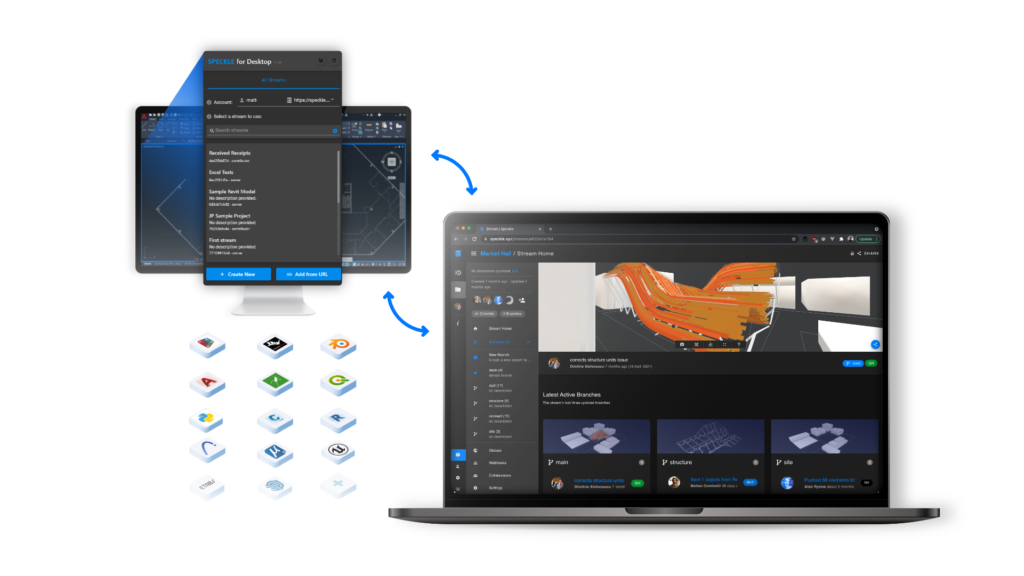
Thank you Dimitrie, Matteo, and the entire community for making Speckle so f*** awesome
If you are a 3D creator, and hate the old ways – hop over to Speckle and join the community, or drop Dimitrie and Matteo an old-fashioned email.
And if you are a founder in 3D or 2D, we’d love to hear from you !



